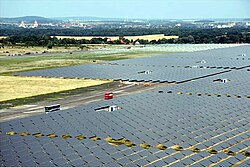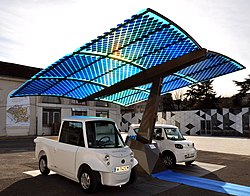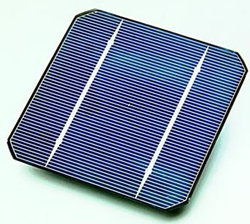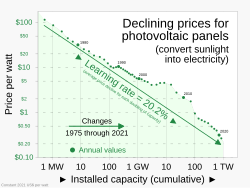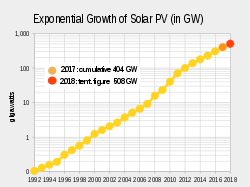Photovoltaics
| Photovoltaic power worldwide GWp | |
|---|---|
| 2000 | 1 |
| 2005 | 5 |
| 2010 | 40 |
| 2011 | 70 |
| 2012 | 99 |
| 2013 | 136 |
| Year end capacities | |

Photovoltaics (PVs) are arrays of cells containing a solar photovoltaic material that converts solar radiation or energy from the sun into direct current electricity. Due to the growing demand for renewable energy sources, the manufacturing of solar cells and photovoltaic arrays has advanced considerably in recent years, and costs have dropped.[1][2][3]
Solar photovoltaics are growing rapidly, from a small base, to a total global capacity of 130,000 MW at the end of 2013. More than 100 countries use solar PV.[4] Installations may be ground-mounted (and sometimes integrated with farming and grazing)[5] or built into the roof or walls of a building.
Panels
Photovoltaic solar panels come in many different voltages. The most common are 12 volts, 24 volts, and 48 volts. Like batteries, multiple solar panels can be connected together to produce higher voltages, for example, two 48 volt panels connected together would produce 96 volts. The inverter, batteries, and solar panels in a system are usually all of the same voltage. The advantage of a higher-voltage system is that thinner wire is used, which is less expensive and easier to pull through conduit. The disadvantage of a higher-voltage installation is that electric shock and arc flash become more of a hazard, so installations above 48 volts are usually only found in solar power plants or commercial buildings.
A photovoltaic installation typically includes an array of solar panels, an inverter, rechargeable batteries (for use at night), a charge controller (a device that prevents the batteries from over-charging), two GFCI circuit breakers (one before the inverter and one after), and interconnection wiring. There is sometimes also a transformer after the inverter, which can power 240 volt heavy appliances such as a clothes dryer or oven. The transformer is often part of the inverter and can't be seen. Everything past the inverter (or transformer if there is one) is set up like a normal utility-fed installation (breaker panel, lights, outlets, switches, etc.). If there is no transformer, only 120 volt devices may be used. Installations without a transformer must be labelled as such on the breaker panel to alert future electricians that 240 volt appliances can not be installed. Some installations have direct current (DC) lighting and possibly DC appliances. The advantage of this is that for DC loads, the losses in the inverter are avoided. These installations will have a separate DC breaker panel connected before the inverter. For safety reasons, DC wiring cannot be run in the same conduit as AC wiring, and DC outlets must not accept an AC plug and vice versa.
World's Largest PV Power Stations (outdated)
- Photovoltaic power plants
Solar Cells
A solar cell or photovoltaic cell is a device that changes light energy into electricity. Photovoltaics are best known as a method for making electricity by using solar cells to change energy from the sun into a flow of electrons. The photovoltaic effect was first noticed by Alexandre-Edmond Becquerel in 1839. Eric Seale (July 11, 2003). "Photovoltaic Effect". Archived from the original on 12 October 2010. Retrieved 24 May 2012. Practically all photovoltaic devices are some type of photodiode.
Solar cells can be used to power tools or to recharge a storage battery. The first actual request of photovoltaics was to power orbiting satellites and other spacecrafts, but today the most photovoltaic modules are used for grid connected power creation. In this case a tool called an inverter is required to convert the direct current to alternating current. Cells require protection from the environment and are usually packaged tightly behind a glass sheet. When more power is required than a single cell can give off, cells are electrically connected together to form photovoltaic modules, or solar panels. A single module is enough to power an emergency telephone, but for a house or a power station the modules must be arranged in multiples as arrays.
Photovoltaics Media
Solar cells generate electricity directly from sunlight.
Swanson's law–stating that solar module prices have dropped about 20% for each doubling of installed capacity—defines the "learning rate" of solar photovoltaics.
AWM Munich ETFE Cushions-Photovoltaics
Notes
- ↑ German PV market
- ↑ "BP Solar to Expand Its Solar Cell Plants in Spain and India". Archived from the original on 2007-09-26. Retrieved 2011-10-24.
- ↑ Large-Scale, Cheap Solar Electricity
- ↑ REN21 (2011). "Renewables 2011: Global Status Report" (PDF). p. 22. Archived from the original (PDF) on 2012-05-13. Retrieved 2011-10-24.
- ↑ "GE Invests, Delivers One of World's Largest Solar Power Plants". Archived from the original on 2009-12-17. Retrieved 2010-04-09.
- ↑ Steve Leone (7 December 2011). "Billionaire Buffett Bets on Solar Energy". Renewable Energy World. Archived from the original on 8 November 2014. Retrieved 9 July 2014.
- ↑ "The Tribune: California Valley's Topaz Solar Farm now producing electricity". Archived from the original on 2015-03-03. Retrieved 2014-11-10.
- ↑ China Daily: World's largest solar-hydro power station getting connected to the grid
- ↑ "SolarServer: CPI completes massive hybrid solar PV/hydro plant in Western China". Archived from the original on 2014-12-17. Retrieved 2014-11-10.
- ↑ Solar Star Project, Japan DG Demand Drive SunPower's Q3, Forbes, 10/31/2014
- ↑ "Solar Star I & II Solar". Archived from the original on 2014-12-14. Retrieved 2014-11-10.
- ↑ Energy Division Resolution E-4229
- ↑ U.S. Solar Market Trends 2013 Archived 2014-10-21 at the Wayback Machine, IREC, July 2014
- ↑ Meza, Edgar (27 June 2013). NRG Energy completes 250 MW California Valley Solar Ranch. Solar Energy Industry Association. http://www.seia.org/news/nrg-energy-completes-250-mw-california-valley-solar-ranch. Retrieved 5 July 2013.
- ↑ 15.0 15.1 "RPS Project Status Table - February Update". Archived from the original on 2012-07-23. Retrieved 2014-11-10.
- ↑ [https://web.archive.org/web/20130501122808/http://investor.firstsolar.com/releasedetail.cfm?ReleaseID=706034 Archived 2013-05-01 at the Wayback Machine World's Largest Operational Solar PV Project,
- ↑ "First Solar Stops Installation at Agua Caliente Project". Bloomberg. https://www.bloomberg.com/news/2012-08-30/first-solar-stops-installation-at-agua-caliente-project.html.
- ↑ World’s Biggest Solar PV Plant a Feather in DOE’s Cap, Pete Danko, greentechmedia, May 2, 2014
- ↑ "AV Solar Ranch One". NextLight Renewable Power LLC. 2009. Archived from the original on 2009-10-17. Retrieved 2009-06-06.
- ↑ Project Overview
- ↑ Hill, Joshua (22 Feb 2013). Antelope Valley Solar Ranch One Achieves 100 Megawatt Milestone. http://cleantechnica.com/2013/02/22/antelope-valley-solar-ranch-one-achieves-100-megawatt-milestone/. Retrieved 1 February 2013.
- ↑ "DOE Closes on Four Major Solar Projects". Renewable Energy World. 30 September 2011. Archived from the original on 7 January 2016. Retrieved 9 July 2014.
- ↑ "Gujarat Power Corporation Ltd". Archived from the original on 2014-04-15. Retrieved 2014-11-10.
- ↑ India Pushes Ultra-Mega Scheme To Scale Solar PV, Forbes, William Pentland, 9/09/2014
Other websites
| Wikimedia Commons has media related to Lua error in Module:Commons_link at line 62: attempt to index field 'wikibase' (a nil value).. |
- How Stuff Works: Solar cells.
- Energy Atlas of the West Archived 2022-02-02 at the Wayback Machine
- World's largest photovoltaic power plants
- Information pertaining to photovoltaic solar electricity in each of the IEA PVPS member countries Archived 2005-10-27 at the Wayback Machine
- Photon Magazine International PV magazine
- Renewable Energy World magazine Archived 2008-07-05 at the Wayback Machine
- US Department of Energy Energy Efficiency and Renewable Energy
- http://science.nasa.gov/science-news/science-at-nasa/2002/solarcells/
- Photovoltaic components, projects and howtos


